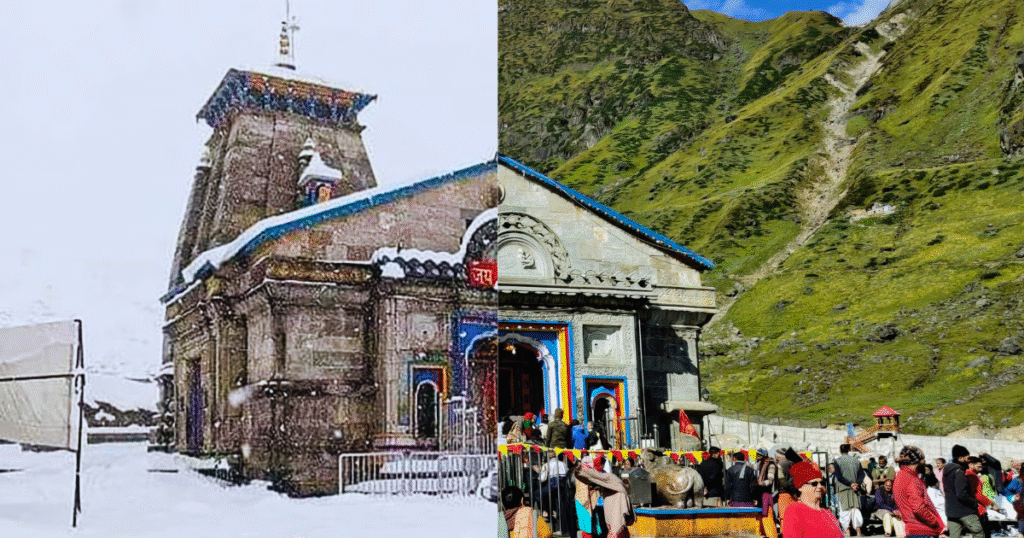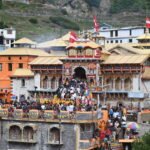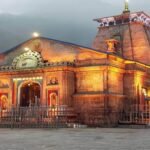
Introduction: The Call of the Mountains
You know, some trips start with a calendar and a flight booking—and then there are journeys that begin with a whisper in your soul. A calling.
Kedarnath is absolutely that place.
As the winding roads of Uttarakhand narrow, and the sound of horns gives way to the rustle of pine, you start to feel a subtle shift inside you.
When I first set foot in that valley, I wasn’t just going to a temple; I was walking toward faith itself.
History and Significance: The Legend of Lord Shiva’s Abode
Every temple in India has a legend, but Kedarnath’s feels like it was carved by the mountains with a divine chisel.
“Okay, so the legend is this: right after the epic Mahabharata battle, the Pandavas were seeking Lord Shiva’s forgiveness for all the lives they took. But Shiva? He wasn’t having it! He completely dodged them, disguising himself as a bull and hiding deep in the Garhwal Himalayas.”When the Pandavas finally tracked him down and the mighty Bhima managed to grab his hump!
It’s said that Shiva’s hump reappeared here at Kedarnath, while the other parts of his body emerged in four other spots—forming the Panch Kedar (Kedarnath, Tungnath, Rudranath, Madhyamaheshwar, and Kalpeshwar).
So, this became a sacred spot where the very essence of Shiva—the Destroyer and Transformer—resides. The stone temple you see today is believed to have been built originally by the Pandavas and later rebuilt by Adi Shankaracharya in the 8th century.
To stand before that temple, surrounded by icy peaks and ancient chants, you truly realize that time itself bows down here. For centuries, people have braved impossible weather and dangerous trails just to get one glimpse—one Darshan—of that divine Jyotirlinga.
They say a visit to Kedarnath grants moksha (liberation). And honestly, after walking those same ancient paths, you start to grasp why.

Location and Geography: Where Heaven Touches Earth
Kedarnath is tucked away in the Rudraprayag district of Uttarakhand, right at the source of the Mandakini River, guarded by the immense Kedarnath range.
The Mandakini flows right past the temple, its freezing waters sparkling in the sun. In the early mornings, mist dances over the river, and the peaks just glow golden with the first light. It’s so silent at dawn that even the sound of your own breath feels sacred.
Everywhere you look, towering deodar and rhododendron forests meet glacial streams.
Best Time to Visit Kedarnath
Because of the severe weather, the temple only opens its doors for a few months each year, usually from May to November.
The Sweet Spot: May–June (spring/early summer) and September–October (post-monsoon). The skies are clear, the flowers are blooming, and the trekking routes are at their best.
Avoid: July–August (Monsoon). Heavy rain means a high risk of landslides and makes the trek dangerous.
Closed: November–April (Winter). The region is buried in snow. The idol is lovingly moved to the Omkareshwar Temple in Ukhimath for the winter months.

How to Reach Kedarnath
You can reach there by train by air or by Road: Buses and shared jeeps run constantly from Rishikesh/Haridwar/Dehradun to Guptkashi and Sonprayag. A shuttle takes you from Sonprayag to Gaurikund—that’s the very last point a vehicle can take you.
The Final Stretch:
Trek: The famous 16 km trek from Gaurikund is the heart of the Yatra.
Helicopter: If you can’t trek, helicopter services are available from Phata, Sersi, and Guptkashi. Book this far in advance!
Quick Tip: Seriously, pack layers. Even in summer, the temperatures drop like a rock after sunset. Also, get your Yatra registration done—it’s mandatory!
The Trek Experience: A Walk of Faith
If there’s one moment that defines the entire Kedarnath Yatra, it’s that 16 km climb from Gaurikund.
The trail starts at first light. You’ll see pilgrims—young, old, fit, frail—all chanting “Bam Bam Bhole” as they begin. The sun’s first rays hit the mountains, painting them in gold and orange.
The 16 km path is tough.But honestly, every step feels meaningful. You meet amazing people: some are walking barefoot, some are on ponies, and others are being carried on palanquins—all driven by a devotion that’s stronger than any fatigue.
Little dhabas dot the route, selling piping hot tea, Maggi, and steaming plates of rajma-chawal. You sit there, you sip your tea, and you look around—and you realize you’re surrounded by nothing but pure devotion and mountain silence.
As you climb higher, the air gets thinner, but you’ll find your faith thickens. The final approach to Kedarnath feels like walking through the clouds. And then, there it is. The temple. Standing powerfully against the white peaks, draped in prayer flags and mist.
That first sight of Kedarnath Temple is something no photo, no video, can ever capture. People cry. Some just stand in silent awe. Others shout “Har Har Mahadev!” at the top of their lungs. In that moment, you realize this wasn’t just a journey up a mountain. It was a journey inward.
A Place to Stay
Even though it’s remote, Kedarnath has basic but cozy options for pilgrims.
In Kedarnath: You’ll find GMVN Guest Houses (clean, reliable government-run stays), Temple Trust Lodges right near the temple, and private tented camps during peak season.
Down the Valley: If you need something with better amenities, stay overnight in Guptkashi or Phata. They have comfortable hotels and resorts.
Pro-Tip: If you’re traveling in May or June, always book your accommodation ahead of time!

Temple Timings and Rituals
The temple usually opens around 4:00 AM with the incredible Mangala Aarti—a mesmerizing ritual done by torchlight with conch shells echoing everywhere.
Morning Darshan: 4:00 AM – 7:00 AM
Afternoon Break: 3:00 PM – 5:00 PM
Evening Aarti: Around 7:00 PM
The Evening Aarti is one of the most moving experiences you can have here. As the bells ring and lamps flicker in the dark sky, the chants swell, merge with the cold wind, and dissolve into the mighty Himalayas. Witnessing the annual Kapat (door) opening or closing ceremony is like watching faith breathe and sleep for the season.
What Kedarnath Teaches You (My Own Take)
When I first stood before the Kedarnath Temple, I didn’t pray for anything at all. I just stood there, completely silent, watching the clouds roll over those huge peaks, feeling the cold wind on my face. After all those days of journeying and difficult terrain, I finally understood something: This place wasn’t about reaching; it was about surrendering.
Kedarnath teaches you humility. It teaches you that no matter how small you feel against these towering mountains, your faith makes you infinite. You see old women climbing barefoot, young porters carrying pilgrims on their backs, and volunteers serving tea in freezing conditions—and you truly understand what devotion means.
The Himalayas will test your body, but Kedarnath touches your soul.
When you finally leave, you don’t say goodbye—you say, “Phir milenge, Bhole Baba ke darbar mein.” (We will meet again, in the court of Bhole Baba.)
Even months later, the memory of those chants—“Har Har Mahadev”—still echoes inside me. And that, I believe, is the truest gift of the Kedarnath Yatra.
Frequently Asked Questions (FAQs)
1. When does the Temple open/close? Usually late April/early May to late October/early November (it depends on the lunar calendar).
2. How hard is the trek? It’s moderately difficult—16 km uphill from Gaurikund. If you have basic fitness and take breaks, most people finish it in 6–8 hours.
3. Can senior citizens or kids visit? Yes, if they’re medically fit. Seniors often use the helicopter or assistance. There are medical camps along the route.
4. What kind of food is available? Only vegetarian food is served (rice, chapati, dal, tea). The area follows a strict satvik food tradition. Bring your own dry fruits for the trek.
5. Is there any company which provide Kedarnath yatra package? Yes there are many tour and trekking companies in Uttarakhand but The Mountain Trekker is considered to be the best amongst them.
Final Thought
Kedarnath isn’t just a destination—it’s an awakening.
You arrive carrying your worries, and you leave carrying profound peace.
Amidst those eternal mountains, you end up finding the one thing you didn’t even know you were looking for: yourself.
Har Har Mahadev. May Lord Shiva bless every traveler who listens to the call of Kedarnath.



Leave a Reply